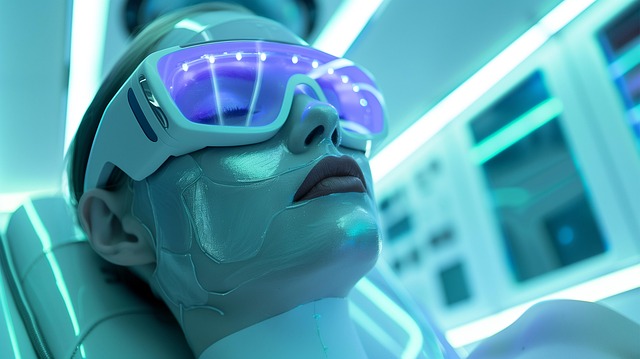Chemical peels are non-invasive acne facial treatments using acid solutions to exfoliate skin, unclog pores, and improve texture. Tailored acids like glycolic and salicylic acid target specific skin concerns, with professional application minimizing side effects and stimulating collagen for long-term skin health. Popular for acne facial treatments, these peels offer both short-term improvements and long-lasting solutions.
“Uncover the power of chemical peels—a game-changing approach to skincare. This comprehensive guide explores how these innovative procedures transform your skin. From ‘understanding chemical peels’ to their science-backed benefits, we delve into effective acne treatment solutions. Discover the art of various peel types and techniques, designed to reveal healthier, radiant skin. Explore why chemical peels are becoming a top choice for those seeking advanced facial treatments.”
Understanding Chemical Peels: A Deep Dive
Chemical peels, a popular skincare procedure, are a series of treatments that utilize chemicals to exfoliate and rejuvenate the skin. This deep cleaning process helps eliminate dead skin cells, unclogs pores, and promotes new cell growth, resulting in smoother, more even-toned skin. It’s particularly effective for those seeking acne facial treatments, as it can minimize scarring and improve overall skin texture.
During a chemical peel, a solution with specific concentrations of acids is applied to the face, depending on the desired effect. These acids gently lift away the outer layer of skin, exposing healthier skin underneath. This procedure offers a non-invasive approach to various skin concerns, including acne scars, fine lines, and hyperpigmentation. It’s essential to choose the right acid for your skin type and condition to ensure optimal results and minimize potential side effects.
The Science Behind Their Skin Benefits
Chemical peels, a popular skincare treatment, have gained significant attention for their ability to transform and enhance skin health. The science behind their benefits lies in carefully controlled chemical solutions that gently exfoliate the top layers of the skin, removing dead cells and unclogging pores. This process allows for deeper cleansing and stimulation of the skin’s natural regeneration.
The key to their effectiveness is the selection of specific acids like glycolic, lactic, or salicylic acid, tailored to address various skin concerns. For instance, glycolic acid, a common ingredient in acne facial treatments, penetrates deep into pores, breaking down skin debris and promoting cell turnover. This not only helps clear existing breakouts but also prevents future acne by unclogging follicles. The result is smoother, more even-toned skin with improved texture, making chemical peels a top choice for those seeking effective acne management and overall skin rejuvenation.
Acne Treatment: How Chemical Peels Help
Chemical peels, a popular skin treatment for various conditions, offer a unique and effective approach to acne management. These peels involve applying chemicals to the skin’s surface, which helps exfoliate and rejuvenate it. For acne-prone skin, this process is a game-changer. By removing the top layer of damaged or infected skin cells, chemical peels unclog pores, reducing the appearance of blemishes and preventing future breakouts.
This non-invasive procedure promotes healthier skin by stimulating collagen production, which strengthens the skin’s structure. As a result, acne scars may fade, leaving behind smoother and more even skin. Combining chemical peels with proper skincare routines can provide lasting effects, making them an excellent choice among various acne facial treatments.
Exploring Different Peel Types and Techniques
Chemical peels offer a diverse range of options, each tailored to address specific skin concerns. From alpha hydroxy acids (AHAs) and beta hydroxy acids (BHAs) to retinoids and salicylic acid, various chemical compounds are used in different concentrations to target issues like acne, hyperpigmentation, and fine lines. AHAs, for instance, are gentle yet effective for exfoliating the skin’s surface, while BHAs penetrate deeper to unclog pores, making them ideal for acne-prone skin.
Techniques also vary, with some peels applied as a thin layer left on for several minutes, while others involve a more intense application and subsequent rinsing. Professional administration ensures optimal results, especially for stronger peels that can cause temporary redness or irritation. These treatments not only provide immediate benefits but also help to stimulate collagen production, leading to improved skin texture and tone over time, making them popular choices among those seeking effective acne facial treatments.
Chemical peels emerge as a powerful tool in the arsenal of skincare, offering significant benefits for various skin concerns, particularly in the realm of acne facial treatments. By gently exfoliating the skin’s top layer and stimulating collagen production, these peels promote a healthier, more radiant complexion. Whether it’s lactic acid for gentle resurfacing or stronger options like salicylic acid for deeper unclogging, understanding chemical peels can help individuals make informed choices for their skin health. As you navigate the world of skincare, keeping an eye on these innovative treatments could be a game-changer in achieving clear and glowing skin.
